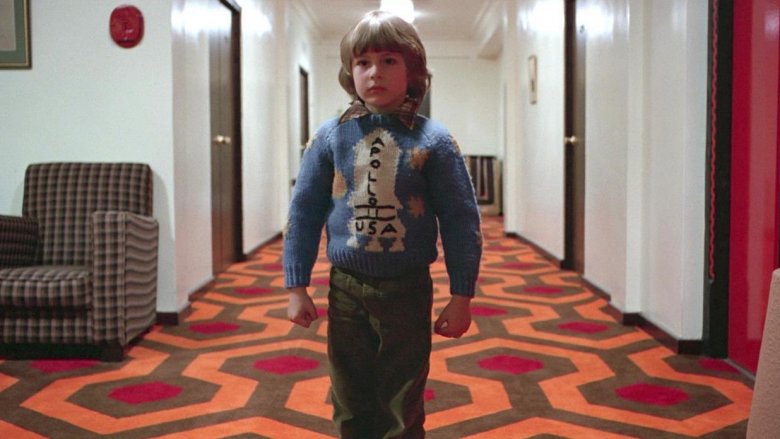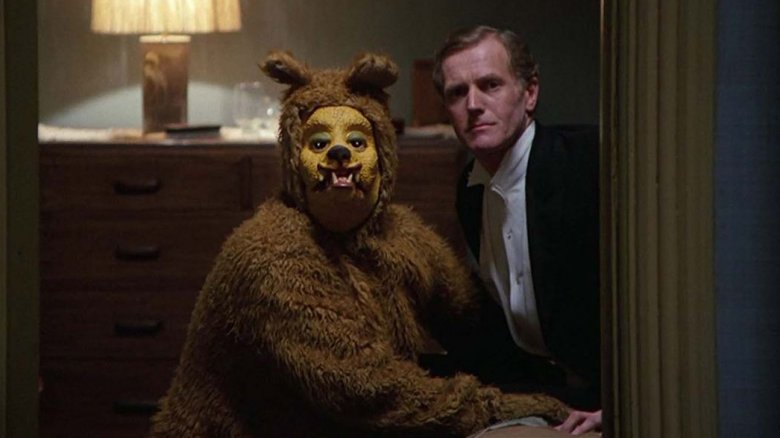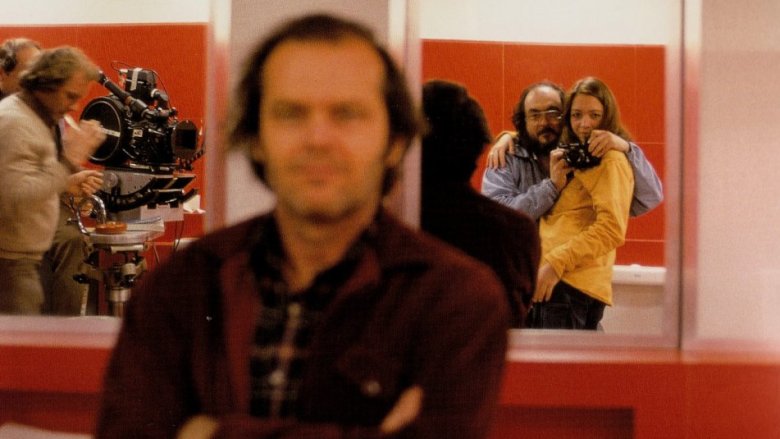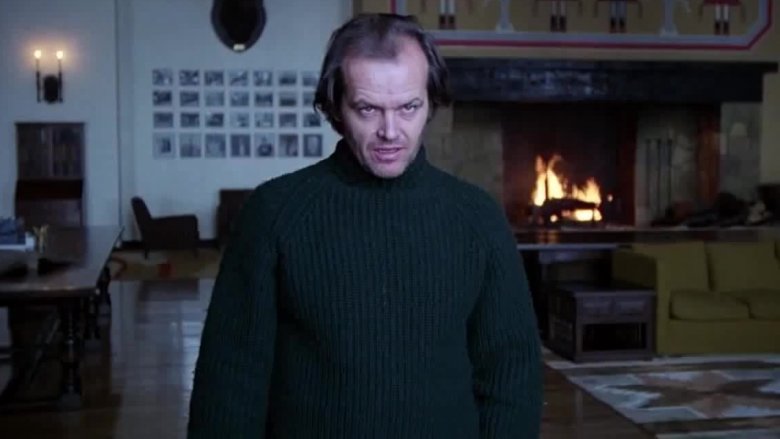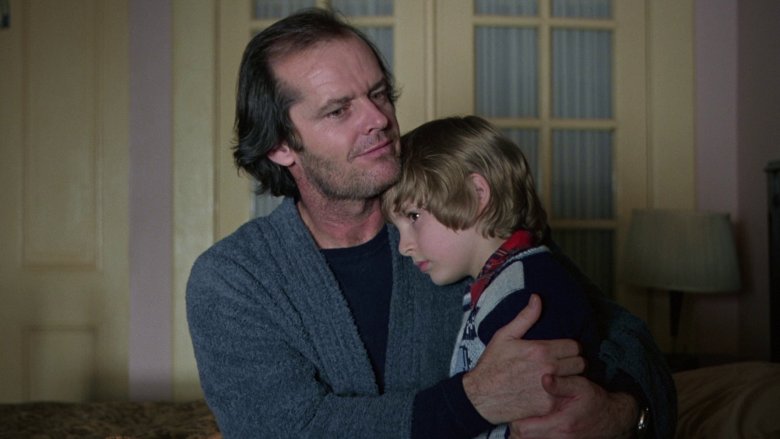How The Shining Changed Horror Movies And No One Noticed
When Stanley Kubrick's adaptation of Stephen King's The Shining first hit theaters in 1980, the film received mixed reviews. As the years have progressed, though, it has not only cemented itself in the upper echelons of cinematic greatness, it's become a pop culture phenomenon.
The Shining works as a supernatural ghost story as well as an exploration of a tortured man's downward spiral into homicidal madness. The elevated manner in which the story of the Torrance Family's trip is told helps the whole thing blossom into an experience as visceral as it is cerebral. Great storytellers often challenge themselves by placing their lead characters into seemingly impossible traps with no sign of escape. Not only does The Shining do this, it traps the audience in as well — enclosing us in the ominous Overlook Hotel along with Jack, Wendy, and Danny — as we witness the events unfold within its gripping confines.
Kubrick's masterpiece has since inspired countless works of art, film, TV, and music. From its ingenious sound design to a limited use of gore to Jack Nicholson's iconic portrayal of Jack Torrance, The Shining changed horror movies forever. Here's how.
The horrific duality of human nature
One look at the Grady girls and it's easy to see just how impactful an image of twins standing side by side has become. And yet, while The Shining made their appearance a jarring component that has been used time and again in the genre, Stanley Kubrick takes the duality this image represents and expands on it exponentially. We learn early on that Jack Torrance is a recovering alcoholic, alluding to the abusive person he becomes under the influence. That Dr. Jekyll/Mr. Hyde-style battle between good and evil, dark and light, is explored throughout the film in various ways.
It's as if the movie itself is wearing a mask. And as the Overlook Hotel begins to reveal its sinister secrets — whether it's through Dick Hallorann's (Scatman Crothers) silent bonding with Danny (Danny Lloyd) over their psychic abilities, Danny's communication with his imaginary friend Tony, or Jack's interlude with the naked dead woman in Room 237 — it becomes clear that, much like in real life, we can never truly know anyone ... including ourselves.
As supernatural as The Shining feels on the surface, the crux of the tale lies within that eternal conflict between dark and light. When the mask comes off, and those personal demons reveal themselves, hidden horrors come to the surface, and this newly introduced reality cuts straight to the psychological quick.
Out of the shadows, into the light
One of the ways The Shining stands out from the horror crowd is through Stanley Kubrick's hyper-realistic lens. This terrifying tale is not told in the familiar shadowy environment most scary stories exist in. In fact, the majority of the film takes place in broad daylight. Add Kubrick's signature style to the mix, and the result is one beautiful looking movie.
Relying on the natural surroundings The Shining takes place in helps to deliver an intellectual component that was mostly missing in the genre up until this point. It's one of the reasons fans still debate whether The Shining is even a horror movie to begin with (Spoiler: it is!).
With common tropes out of the way, Kubrick's signature sense of cinematic framing and lighting helps to place the audience firmly into the mood and world of the Overlook Hotel. The story becomes accessible in a way that many horror movies don't. As supernatural as things become, this is still a human story. Kubrick nails this point home by presenting each frame with a heightened sense of realism that pushes psychological boundaries in a way that's almost unnoticeable. Everything seems fine.
Disrupting this genre formula not only keeps viewers on their toes, it also results in a compelling story that never stops being creepy. The Shining is all about mood, and the tone in which the story is presented assaults the senses with a whisper while burrowing into the dark recesses of the mind.
Sound, silence, and everything in between
Not only does Stanley Kubrick focus on the get-under-your-skin moments throughout The Shining, from the visual foreshadowing presented in the opening scenes that bring Jack Torrance to the Overlook Hotel to the final chase in the ominous snowy hedge maze out back, Kubrick commits to creeping out audiences through an unexpected use of sound and silence. As we've been reminded with the box office success of A Quiet Place, silence can be a major tool in amplifying a sense of dread and danger. Kubrick was a master of this.
There are moments throughout The Shining — following Danny's tricycle through the Overlook's winding hallways come to mind — where the audience only hears the sounds of the wheels regularly transitioning from the hard floor to the soft carpet. It's not much to watch, really, but as the camera follows Danny, our perspective is minimized and becomes childlike. Add that to the unexpected sound cues of the movie's score, where audio crescendos don't coincide with the events onscreen, and the results are quite unnerving.
The result finds the audience no longer receiving warnings that the visual horrors are right around the corner. And with those guidelines thrown out of whack, a steady stream of dread and anxiety comes into play. We're experiencing everything as the characters do. All work and no play, indeed.
An aversion to blood
Stanley Kubrick wasn't a fan of overusing blood in his movies. Screenwriter Diane Johnson told Entertainment Weekly, "Kubrick didn't want it to be too gory, he thought a lot of blood was vulgar." In a post-torture porn era, where the genre has re-embraced the notion of less is more, it's easy to agree.
When you think of The Shining, it's impossible to avoid that iconic bloody elevator scene. As Wendy runs through the halls of the Overlook, trying to escape Jack, the spirits finally present themselves. As she turns a corner, with knife in hand, she witnesses an elevator spew blood, flooding the hallway. Now let's be clear here: That is a lot of blood. But, taking the story of The Shining into perspective, Johnson refers to this scene as "more ornamental and metaphorical — it's different than seeing people get stabbed." Wendy isn't blessed with the psychic abilities her son has, but this is a Stanley Kubrick joint. Every visual detail that exists within The Shining, from the carpet's maze design to the Native American artwork, all have a purpose.
Again, there's definitely blood in The Shining. The chopped up Grady girls add to the story, giving a glimpse into the the Overlook's horrific past, while foreshadowing the maniac Jack will become. Dick Hallorann's death scene solidifies Jack's transformation. Aside from that, the viscera delivered here is delivered on a cognitive level, revealing emotional distress as one of Kubrick's greatest weapons.
A high quality production
We've already mentioned the film's color palette and uncharacteristic use of light and realism to add to the terror, but The Shining doesn't stop there. What Stanley Kubrick pulled off is akin to the other classics in his cinematic repertoire: He made a well produced, well-acted, well-written film. For decades, the horror genre has fought tooth and nail to climb its way out of the jokey, B-movie recesses that have remained its home.
But when you take a closer look at the sinister world of monsters and zombies, you'll find the origins of some of today's most revered movie makers. Peter Jackson, Guillermo del Toro, James Gunn, Sam Raimi ... these are just a handful of storytellers who got their start by scaring audiences. The thing they all have in common with Stanley Kubrick, especially with regards to The Shining, is their attention to detail and love of storytelling. And in cinema, a story is pieced together through a cavalcade of moving parts.
At its heart, The Shining is the tale of a family fractured as its patriarch descends into madness. It's a story that'd be easy enough to tell under low-budget circumstances, but Kubrick was a perfectionist. He elevated the genre through cutting edge methods and high-quality production — the newly invented Steadicam was put to good use here — regularly rewriting the script, while pushing his actors to their limits. These standards not only left an impact on horror movies, they forever changed cinema.
An allegory for addiction
Much like Stephen King's classic source material, Kubrick's movie explores the physical and symbolic ghosts that inhabit the Overlook Hotel. As CinemaBlend points out, King has long been vocal about hating Kubrick's adaptation, due in part to the liberty the director took in changing huge parts of the novel, taking the story in a darker, cerebral, more tormented direction.
Kubrick focused more on the personal demons Jack Torrance and his son Danny were dealing with. Yes, there are still spirits haunting the hotel. But their appearance here coincides with Jack's own troubled past. Almost immediately, audiences are informed of Jack's alcoholism and the violence Danny dealt with as a result of Jack's addiction. The ghost story is the proverbial mask to the deeper, more human horrors being explored in The Shining.
Kubrick originally signed on by getting King to agree he could change anything he wanted from the book. More than anything, Kubrick wanted the movie to focus more on the real things that go bump in the night. According to The Guardian, he told King: "I think stories of the supernatural are fundamentally optimistic, don't you? If there are ghosts then that means we survive death." Instead, The Shining surrounds the viewer with death, ultimately making human behavior the story's smoking gun.
The sins of the father
Jack Nicholson's nuanced portrayal of Jack Torrance is integral to the whole story. Without this emotional unraveling, from his struggles with addiction to to the abuse he doled out to both Wendy and Danny, The Shining may have become just another formulaic walk in the park. But again, Kubrick's film isn't just a ghost story. This is the story of Jack's dangerous actions, and the traumatic reactions of his unfortunate son.
Those familiar with Stephen King's book, and its sequel Doctor Sleep, know that Danny's shining ability was something Jack may have been gifted with as well. But his means of coping with the world around him drove Jack to pick up the bottle, burying whatever clairvoyant talents he had, revealing a much darker side in the process. There's a hereditary component here. If Danny and his father shared a psychic psyche, the father-son connection would take on a whole new meaning. Not only does this once again tie back to the theme of duality, it paints a picture of a son's mission to separate himself from the sins of his father — for fear of repeating them himself.
Flipping the evil child horror trope on its head
Before The Shining hit theaters, a popular trope explored in horror was that of "The Evil Child." From the Twilight Zone episode "It's a Good Life" to films like Village of the Damned and The Omen, the creepy child motif had been a strong one in genre entertainment. It still is, but The Shining represented the beginning of a transition. Suddenly, movies started paying less attention to the young Antichrist wreaking havoc at home, and focused more on telling empowered tales of survival and redemption through the innocent perspective of the children themselves.
In putting Danny Torrance in a position of power — with the help of Dick Hallorann showing him the how to "shine" — the boy became the beacon of hope throughout the entire film. As the '80s progressed and films like A Nightmare on Elm Street, It, and The Goonies arrived, the trend of empowered children gaining the upper hand against the evil adults of the world grew exponentially. Kubrick's The Shining flipped the proverbial script, turning this adult/child dynamic on its head.
Stanley Kubrick's Kabuki Theater
Stanley Kubrick had a reputation for pushing his actors to their breaking point. Shelley Duvall spoke to Roger Ebert in 1980 about the harrowing experience, recalling, "Jack Nicholson's character had to be crazy and angry all the time. And in my character I had to cry 12 hours a day, all day long, the last nine months straight, five or six days a week." Pushed to the psychological brink day in and day out took its toll on Duvall, who appeared in a 2016 Dr. Phil episode that triggered outrage and concern.
According to Horror, "[Kubrick] frequently kept [Duvall] isolated, cut many of Wendy's lines and forced her to perform the iconic 'baseball bat' scene an exhausting 127 times." It took 13 months for the production to wrap. Emotionally exhausted and pushed to their limits, what Duvall and Nicholson did with their characters took things to an ultra-heightened space, both physically and mentally.
When The Shining originally hit theaters, the overall response was mixed. Oscar-winning director Steven Spielberg described the movie — specifically Jack Nicholson's role as Jack Torrance — as "almost a great kabuki performance. It was almost like kabuki theatre." Comparing Kubrick's movie to Japan's highly stylized art form may sound like a reach, but the theatrical use of makeup, music, drama, and dance mine a deeply emotional well similar to the one Kubrick's work thrived in.
The Overlook Hotel is the main character
If you were one of the many watching the 90th Annual Academy Awards, you may recall an odd advertisement that aired during a commercial break. Presented like one of the many ads that promote travel to tropical destinations, the 30-second spot invited viewers to visit the Overlook Hotel. As the camera panned down those familiar hallways, the Gold Ballroom, and into Room 237, it became clear once more just how iconic the Overlook had become. Without it, The Shining just wouldn't be the same.
Oregon's Timberline Lodge was used to represent the exteriors of the massive building in the movie, with Colorado's Stanley Hotel acting as Stephen King's original inspiration to pen the subject matter in question. Regardless, the notion of a haunted building as a main character in a horror story is nothing new. But as The Shining unfolds, it become evident that the Overlook is the movie's real monster. As Delbert Grady (Philip Stone) tells Jack Torrance during their pivotal bathroom chat, he's always been the caretaker. Physically speaking, that couldn't be true. But psychologically, there was a mental connection between the building's bloody history and Jack's own tortured demons.
Jack is a monster, no doubt. But when you take a step back and really look at things through Kubrick's metaphorical lens, the Overlook is the immovable object. Like Grady before him, Jack Torrance was just the conduit that helped bring death back to the building's hallowed halls, making The Shining an unstoppable force.
